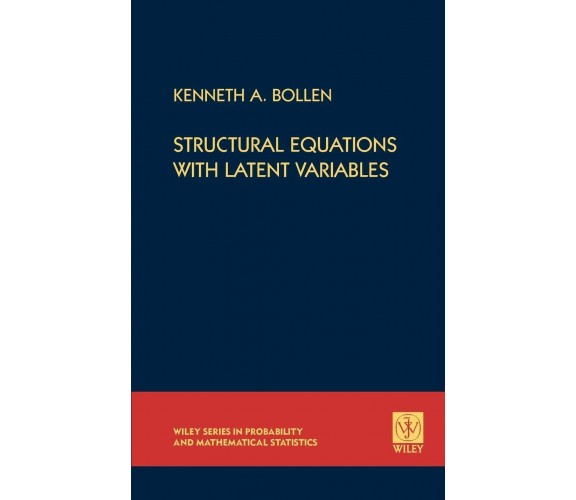Il Tuo Carrello è vuoto
Structural Equations
di Bollen
Editore: John Wiley & Sons
EAN: 9780471011712
ISBN: 0471011711
Pagine: 530
Formato: Hardback
Statistical modeling and its associated terminology have seen tremendous change over the past ten years. Lisrel, covariance structures, latent variables, multiple indicators, and path models are now common phrases used in the analysis of statistical data. The structural equation models associated with these terms are changing researchers’ perspectives on statistical modeling and closing the gap between the way social scientists think substantively and the way they analyze data. In short, these models encompass and extend regression, econometric, and factor analysis procedures. Structural Equations with Latent Variables is a comprehensive treatment of the general structural equation system better known as the Lisrel model. The book serves three purposes. First, it demonstrates the generality of this model. Rather than treating path analysis, recursive and nonrecursive models, classical econometrics, and confirmatory factor analysis as unique, they are treated as special cases of a common model. The second purpose is to emphasize the application of these techniques. Empirical examples appear throughout. Several chapters contain some of the Lisrel or EQS programs the author used to obtain the results for the empirical examples. Finally, the book explores the crucial role played by substantive expertise in most stages of the modeling process. Specifically, the book is arranged as follows: After an introductory overview in Chapter 1, Chapter 2 introduces several methodological tools, while Chapter 3 addresses causality. The regression/econometric models for observed variables are the subject of Chapter 4. In Chapter 5, the consequences of random measurement error in the observed variablemodel are explained. Once it is recognized that variables are measured with error, the relationship between the error-free variable and the observed variable needs to be examined. Chapter 6 does this. Chapter 7 treats confirmatory factor analysis which enables the estimation of measurement models such as those in Chapter 6. Completing this work in Chapters 8 and 9 is the general structural equation model with latent variables. Chapter 8 focuses on the basics, while Chapter 9 treats more advanced topics, including distribution-free estimators and categorical observed variables. Structural equation models can be presented two ways— from the general model to simpler models, or from simpler models to the general model. Structural Equations with Latent Variables develops from the latter strategy, starting with the regression/econometric and factor analysis models and presenting them from the perspective of the general model. Structural Equations with Latent Variables fills the gap existing in the treatment of this subject between introductory texts and specialized papers. It provides social scientists, market researchers, applied statisticians, other analysts, and graduate students with a thorough examination of Lisrel/structural equation models. At the same time it presents new material on measurement reliability and validity, overall fit indices, model identification, and other topics.
di Bollen
Editore: John Wiley & Sons
EAN: 9780471011712
ISBN: 0471011711
Pagine: 530
Formato: Hardback
Statistical modeling and its associated terminology have seen tremendous change over the past ten years. Lisrel, covariance structures, latent variables, multiple indicators, and path models are now common phrases used in the analysis of statistical data. The structural equation models associated with these terms are changing researchers’ perspectives on statistical modeling and closing the gap between the way social scientists think substantively and the way they analyze data. In short, these models encompass and extend regression, econometric, and factor analysis procedures. Structural Equations with Latent Variables is a comprehensive treatment of the general structural equation system better known as the Lisrel model. The book serves three purposes. First, it demonstrates the generality of this model. Rather than treating path analysis, recursive and nonrecursive models, classical econometrics, and confirmatory factor analysis as unique, they are treated as special cases of a common model. The second purpose is to emphasize the application of these techniques. Empirical examples appear throughout. Several chapters contain some of the Lisrel or EQS programs the author used to obtain the results for the empirical examples. Finally, the book explores the crucial role played by substantive expertise in most stages of the modeling process. Specifically, the book is arranged as follows: After an introductory overview in Chapter 1, Chapter 2 introduces several methodological tools, while Chapter 3 addresses causality. The regression/econometric models for observed variables are the subject of Chapter 4. In Chapter 5, the consequences of random measurement error in the observed variablemodel are explained. Once it is recognized that variables are measured with error, the relationship between the error-free variable and the observed variable needs to be examined. Chapter 6 does this. Chapter 7 treats confirmatory factor analysis which enables the estimation of measurement models such as those in Chapter 6. Completing this work in Chapters 8 and 9 is the general structural equation model with latent variables. Chapter 8 focuses on the basics, while Chapter 9 treats more advanced topics, including distribution-free estimators and categorical observed variables. Structural equation models can be presented two ways— from the general model to simpler models, or from simpler models to the general model. Structural Equations with Latent Variables develops from the latter strategy, starting with the regression/econometric and factor analysis models and presenting them from the perspective of the general model. Structural Equations with Latent Variables fills the gap existing in the treatment of this subject between introductory texts and specialized papers. It provides social scientists, market researchers, applied statisticians, other analysts, and graduate students with a thorough examination of Lisrel/structural equation models. At the same time it presents new material on measurement reliability and validity, overall fit indices, model identification, and other topics.
Scrivi una recensione
Nome:
La tua recensione:
Note: HTML non è tradotto!
Voto: Pessimo Buono
Inserisci il codice mostrato in figura:








